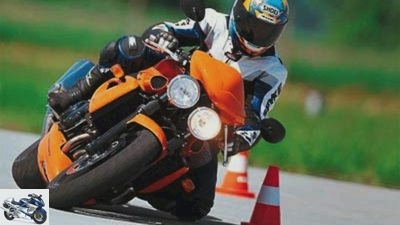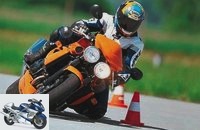Menus

Top test Triumph Speed Four
Just 4 fun
Are the English crazy? Tear off the paneling of the TT 600, make a garish street fighter with wild nostrils and large bulging eyes and paint the whole thing orange. “Never,” complains reason. “Great, bring it on,” the belly roars. And what does the top test say?
There was a fire in England. At Triumph, of all things. And of all things, the first series of the new Speed Four was consumed by the flames. With skin and hair. Which means that the planned delivery for spring was delayed by weeks and you can be happy when you get your hands on something like this without scorch marks for a top test. Of course, the frame and engine are pretty black even without a major fire. But all around it is gaudy. Orange in this case. But if you want, you can insist on light green or black at the nice Triumph dealer. Also nice. And hopefully no different in function than the orange one. Because she can do it.
That’s right, it took a few minutes before the tingling sensation and the desire for the Streetfighter ready-made goods came up. Sneaked around like a curious dog, eyes from the front and back, crawled under, petted over it, saddled up. Has something, the Speed Four. What exactly cannot be said right away, but it can be found out.
Sapperlot, what is it now? Pulling that thing out of the underground car park like an ox. From idle with full pressure – unbelievable. While the fully encased Triumph TT 600 was still a rattling sleeping pill, the English have finally taught their row four in the Speed Four manners. The base of the extremely short-stroke four-cylinder remained untouched, but the new coordination of the interference pipes on the exhaust manifold and valve timing with less overlap help the 600 triumph to achieve a more homogeneous power delivery. An adapted map of injection / ignition and an optimized, now CNC-milled combustion chamber support these auxiliary measures. The result is impressive. Without serious holes or dents, the Speed Four puts an impeccable performance curve on paper. What that is worth can be seen in the performance in the »draft« division. In no other measuring range is the Englishwoman able to depend on the established 600s, even putting the injection engine of the Honda CBR 600 F in the bag. Not to mention the TT 600 sister.
And in real life? Then you applaud the new engine setup and let the Triumph fly with pleasure. So that no misunderstandings arise: the 600 remains a 600, so still a barrel organ, but one that is not annoying and annoying, but instead encourages a dynamic, sporty country game. It is noted that a few horsepower were lost in peak performance during the torque treatment; they are really not missing in the highway robbery, especially since the maneuverability does not end until shortly before the red zone at 14,000 rpm.
To criticize the Triumph engine are at most the tingling vibrations over 7000 / min and the slightly tinny blare as soon as the rider gives the spurs. Oh, yes, the four-in-a-row howls powerfully at a cold start, turns ice cold from standstill to almost 3000 rpm and annoys on the first kilometers with too high idle gas. But otherwise everything is fine on the engine side. The little Triumph flares just 5.4 liters of fuel on the country road. The Honda CBR 600 F injector pumps half a liter more behind the bandage on the same route. The load changes, which are often annoying jerking and hitting with injection engines, are pleasantly smooth with the newly programmed injection. Slightly unsteady and still not quite one hundred percent to be operated due to the gear lever mounted directly on the gearshift shaft, the gearbox requires a bit of getting used to and a consistent step on the lever.
The brisk sorting of the aisles in connection with the brilliant chassis turns into a pure comedy. Snot cheekily tears the Speed Four around the corners, implements the command to turn straight into precisely curled curve radii and casual inclines. This is complemented by the practical range of damper settings on the fork and shock absorber, which has everything from soft to sporty and tight. The chassis irons over rag carpets without being unruly and unmistakably demonstrates the super sporty origins of the Speed Four. The Englishwoman doesn’t really care whether she is bent around tricky hairpin bends or whether the pilot is looking for his kick in fast, long corners. Even with waves and holes, longitudinal grooves or parting joints, nothing wobbles, nothing rocks – great. The Bridgestone BT 010 play along with a good grip and a wide limit range, whereby the BT 010 front tire marked with an »F« makes less nuisance than the standard Bridgestone tire when turning on the brakes.
Although the chassis data and set-up are identical to the TT 600, the half-naked Speed Four conveys more handiness, more agility and more pleasure in cornering on fast motorcycle roads. Logically, this is only the subjective feeling of the driver, to whom the undisguised motorcycle and the unobstructed view of the front wheel suggests more lightness and less mass. But that’s just how he is, the human being, likes to be fooled by outward appearances and masquerade.
Anyone who kills all too well with the weird hustle and bustle should, however, be on their guard; Turning to the left, the front fairing, available as an accessory, planes off the paint and likes to pry out the front wheel on bumps in a generous sloping position. So tough curve freaks prefer to keep their hands off the spoiler.
If you are in a hurry, you can always and everywhere rely on the four-piston brakes, which grapple with force and can be modestly dosed. The pressure point only becomes spongy during hard braking maneuvers with a passenger or a full load at the pressure point. If you don’t want to jeopardize the friendship, the matter with the passenger should be limited to a modest excursion anyway. Little comfort, even less grip and safety during braking and acceleration maneuvers make the pillion seat an emergency seat – nothing more.
To do this, you stay in the first row on a chest of drawers. Handlebar position, notch height, seat cushions, everything perfectly arranged and absolutely identical to the sister TT 600. There is no tubular handlebar like on the big Triumph Speedtriple, instead the arms grip two comfortably high handlebar stubs, plus there are switches, instruments and Fittings that can be operated with links and nothing can be missed. Even a subtle approach of wind and weather protection can be seen when you crouch slightly behind the orange handlebar mask.
ZFinally, another, in the truest sense of the word, gloomy chapter of triumph: the dipped beam, a dull light compared to the current open-space headlights, which makes driving at night an annoying and sometimes dangerous blind flight.
Buy complete article

Top test Triumph Speed Four
Just 4 fun
News and facts
Plus 0 Practical quick-release fasteners for the fuel lines between the tank and the injection system 0 Easy dismantling of the air filter box 0 High-quality plug connections for the electronic components 0 Easily accessible, angled tire valves Minus 0 Cumbersome oil check using a dipstick that has to be screwed in 0 Some M 10 retaining bolts on the frame too long, thread is well over 0 Too short Rear-view mirror arms, thus restricted visibility to the rear 0 Oil drain plug protruding far downwards, can damage the oil pan when touching curbs or the like 0 Too high idle gas of the automatic cold start device for the first few kilometers 0 No splash protection between rear wheel and strut Suspension settings in the test Fork: rebound stage 5 (8) Clicks, compression stage 5 clicks on, spring base 3 rings visible, fork protrusion 10 mmSpring strut: rebound stage 8 (12), compression stage 7 (12) clicks on, pretensioned length of the spring: 161 mm (values in brackets for more comfortable country road use or light driving r / inside)
MOTORCYCLE readings – Triumph Speed Four
MOTORCYCLE measured values Brakes and driving dynamics Brake measurement Braking distance from 100 km / h 38.2 m Average deceleration 10.1 m / s2 Comments: High effectiveness with little manual force, good controllability with consciously initiated braking maneuvers, response behavior that is potentially too toxic in the case of startle braking. Very good braking stability, no bottoming out or twisting of the fork. Handling course I. (fast slalom) Best lap time 20.8 secVmax. at the measuring point 106.1 km / h Comments: Relatively little steering force required, good stability and feedback with a firm setting of the damping. Tight turning point easy to drive due to the gentle load changes and harmonious steering behavior. Handling-Parcours II. (Slow slalom) Best lap time 28.2 secVmax at the measuring point 55.2 km / h Comments: Good steering precision and maneuverability. Stable cornering behavior that is only disturbed by the front spoiler, especially in left-hand bends. Circular path 0 46 meters, best lap time 10.5 secVmax at measuring point 51.4 km / h Comments: Good stability when driving over the bumps on a steep slope. Unfortunately, the front spoiler hits heavily and leverages the front wheel slightly, which is why the Vmax at the measuring point is relatively low. Acceptable tendency to pitch when braking in an inclined position.
Conclusion
Why not? While the sporty, classic Triumph TT 600 is going under between CBR and the like, the new Speed Four can present itself well. The provocative Streetfighter design cannot hide the fact that a dynamic athlete with distinctive cornering talents is under it. And that’s just as well.
Related articles
-
24 pictures Triumph 1/24 Triumph Tiger 800: The three-cylinder engine generates 95 hp at 9300 rpm from 799 cubic meters. Triumph 2/24 Triumph Tiger 800 XC …
-
Top test Triumph Sprint ST ABS
Jahn Top-Test Triumph Sprint ST ABS The punk goes from Punk-Rock: That means fast rhythms, rough voices and simple compositions with three chords …
-
Top test Triumph Tiger The tiger is loose Now it’s gone, the tiger. Escape from the cage and tank, the lithe big cat goes on the hunt …
-
BMW R 1200 R, Triumph Speed Triple and Honda CB 1000 R in comparison test
Bilski 48 pictures Bilski 1/48 Triumph Speed Triple. Bilski 2/48 curve artist. As is typical for Honda, the Honda CB 1000 R also makes it easy for its driver. Thick…
-
Jahn Top-Test Triumph Sprint RS Triad dimensions The sound makes the music. Especially when he has a famous triple like the recently strengthened …
-
Comparison test Suzuki TL 1000 S against Triumph Daytona T 595
Comparison test between Suzuki TL 1000 S and Triumph Daytona T 595 Wilde Herzen They are new, exciting, different. They have rough edges and two wild …
-
Gargolov Top test Triumph Daytona 955i Shadow plays While Japanese and Italian sports cars compete in a merciless race for performance in the glaring…
-
Triumph Speed Triple and KTM Super Duke in comparison
fact 17 pictures fact 1/17 Both bikes are full of power and emotions and can really sweep the rider away, but which one can impress more, the …
-
Triumph Speed Triple S in the top test
r-photography.info 30 images 1/30 Triumph Speed Triple S. 2/30 In addition to rudimentary …
-
Triumph Daytona T595 test Almost lady The UK motorcycle industry has its own representative: the Triumph Daytona T595. She represents the super sports…